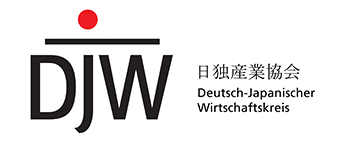Franz Waldenberger, Director of German Institute for Japanese Studies / Board Member of DJW
How sustainable is Japan’s economic upswing?
In its January outlook for economic activity and prices, the Bank of Japan (BoJ) projects a 1.9 percent growth of Japan’s real GDP in the fiscal year 20171 and 1.4 percent for the fiscal year 2018 [1]. This is modest in comparison to China or the US. But China’s growth is driven by its potential to mobilize resources for economic catch-up, whereas the US benefits from the growth of its labour force. Japan’s population in the 15 to 64 years age group, which is considered to constitute the labour population in international statistics, has since 2012 declined by 5.3 million or 6.6 percent [2]. Nevertheless, the actual number of persons employed has risen by 2.4 million or 4.6 percent [3], because more women entered the labour market, more persons beyond the age of 65 remained employed and formerly unemployed persons could find a job. The growth in employment while being induced by the favourable economic environment has at the same time supported the economic upswing. Whether this will continue for long, is however doubtful. The domestic labour market has become extremely tight. Unemployment presently at 2.8 percent is as low as 23 year ago [4]. The ratio of open positions to job seekers is at 1.5, which marks the highest value since the mid 1970s [4]. The shortage of domestic labour has stimulated the inflow of foreign workers. Official statistics show an annual growth rate of 18 percent between October 2016 and October 2017 [5]. In absolute terms, the number of foreign workers increased to 1.3 million. This constitutes a record high level for Japan, but with a ratio of 2.0 of total employment, the figures remain very low in international comparison. To the surprise of many economists, the shortage of labour has despite record high corporate profits not led to a marked increase in the level of wages [6]. One exception is the construction sector, where the shortage of labour has been especially severe given the ongoing reconstruction in the Tôhoku region and the preparations for the upcoming Tokyo Olympics. But even here wages have only risen by seven percent compared to 2012 [6].
Surpluses in trade and tourism
One would expect, that an economy with a severe shortage of labour would increasingly import more products and services from abroad and export less. The opposite holds true. Japan has recently achieved slight surpluses in its trade balance. One reason are the 28 million tourists who visited the country in 2017. 28 million represents a fourfold increase compared to the year 2011 [7]. For the Abe administration, marking a new yearly record over the last five consecutive years is not yet enough. It aims to push the number to 40 million by 2020. Already in 2016, the money spent by inbound tourists surpassed the expenditures of outbound tourists by 1.3 trillion yen [8]. Who would have thought that this would be possible, given the image of the Japanese as fond and frequent international travellers? The broader current account statistics have also shown increasing surpluses over the last years. A main driver has been the income generated by Japan’s overseas investments. The surplus in capital income amounted to 18.2 trillion in 2016, which corresponds to 3.3 percent of GNI. For 2017 the numbers will not be lower [8]. Surpluses in international transactions are not the least the result of movements in the exchange rate. Looking at the historic development of the yen’s real effective exchange rate, we see that the present rate is markedly below the trendline of the last 40 years [9]. The undervaluation of the yen is also clearly visible in purchasing power parity statistics. According to the “Big Mac Index” calculated by the Economist, the yen is presently 35 percent undervalued [10]. This means that products and services in Japan are relatively cheap for foreigners, investments made and income earned abroad have a higher value in yen, and imports into Japan are more expensive.
Japanese fiscal policy…
Looking at the movement of the “Big Mac Index” over time, we can clearly see that the devaluation started at the beginning of Shinzo Abe’s second term as prime minister end of 2012 and the soon after initiated policy of quantitative and qualitative monetary easing by the newly appointed governor of the BoJ, Haruhiko Kuroda. The expansion of Japan’s monetary base has been by far more aggressive than the measures taken by the Fed or the ECB. The since long proclaimed goal of achieving a two percent inflation rate has however still not been reached. Common sense would suggest that a policy trying since many years in vain to achieve a certain goal either pursues the wrong target or applies the wrong instruments. Common sense does not seem to be applied in the evaluation of Japan’s monetary policy. This might partly because of the high complexity of the subject matter, however it is more likely due to the fact that the economy performed quite well under moderate deflation. The “failure” of monetary policy did therefore not bear severe consequences. The economic downturns over the last 20 years were not the result of deflation. They had been caused by events such as the Asian financial crisis, Japan’s domestic financial crisis, the burst of the internet bubble, and most recently and most strongly the Lehman shock and the world financial crisis.
…and who benefits from it
Besides the exporting industries, it was above all the Japanese government that so far benefitted from the historic monetary experiment conducted by Japan’s central bank. It was able to refinance its debt at extremely low interest rates while at the same time extending the maturity. Through its expansionary policy the BoJ acquired more than 40 percent of the outstanding amount of Japanese government bonds (JGBs) [11, 12]. At the end of January 2018, the value of JGBs on the central bank’s balance sheet amounted to 413 trillion Yen, which corresponds to 75 percent of GDP [11]. The financing on the liability side of the BoJ’s balance sheet has mainly occurred through increases in the voluntary reserves of commercial banks. Faced with stagnant credit demand by the private sector commercial banks had no choice, but to return the additional liquidity they had received in the course of monetary expansion back to the BoJ in the form of deposits.
How long can all this be maintained?
We do not only in Japan observe a growing public debt in combination with low inflation and extremely low interest rates. It implies that the savings of the private sector are exceeding private investments on a global scale. The savings surpluses in the private sector allow the public sector to raise money at historically low interest rates. In doing so, the government stabilizes aggregate demand, which is of course a good thing. The crucial question is how long this situation will prevail. Leading economists do not agree on this fundamentally important question. Those, who expect private the investment-savings balance to improve and – as a consequence - interest rates to pick up, argue in favour of consolidating public debt. Those, who expect the savings surpluses in the private sector to continue for a longer period of time, urge the public sector to instead take on more debt in order to stabilize the economy. The Japanese government can only hope that the second scenario will hold true, because then it is just doing everything right. However, given the tight labour market conditions, the further expansion of the economy will nevertheless be limited. This will especially be the case once the undervaluation of the Yen is corrected.
* This essay is an English translation of a German article first published in the January 2018 edition of Kaihô, the bulletin of the German-Japanese Society in Bavaria.
1. Japan’s fiscal year starts 1 April and ends 31 March the following year.
Sources:
[1] Bank of Japan, Outlook for Economic Activity and Prices, January 2018, https://www.boj.or.jp/en/mopo/outlook/gor1801b.pdf
[2] Statistics Bureau, Results of Population Estimates, http://www.stat.go.jp/english/data/jinsui/2.htm
[3] Statistics Bureau, Labour Force Survey, http://www.stat.go.jp/english/data/roudou/index.htm
[4] NIKKEI, 17年の失業率、23年ぶり3%下回る 雇用改善 [Unemployment 2017 for the first time since 23 years again under 3%, improvement of employment], published 30.01.2018, online edition.
[5] Ministry of Health, Labour and Welfare, Situation of Foreign Workers. Summary of Registrations as of End of October 2017, news release 26 January 2018, http://www.mhlw.go.jp/stf/houdou/0000192073.html
[6] Ministry of Health, Labour and Welfare, Monthly Labour Survey, http://www.mhlw.go.jp/english/database/db-l/monthly-labour.html
[7] NIKKEI, 訪日客、最高の2800万人 中韓がけん引し17年2割増 [Inbound Tourist, record high 28 millionen, 20% growth in 2017 driven by tourists from China and South Korea], published 11.01.2018, online edition.
[8] Minstry of Finance, Balance of Payments, http://www.mof.go.jp/english/international_policy/reference/balance_of_payments/index.htm
[9] World Bank, Real Effective Exchange Rate (2010 = 100), https://data.worldbank.org/indicator/PX.REX.REER
[10] Economist, The Big Mac Index. Global exchange rates, to go, 17. Januar 2018, http://www.economist.com/content/big-mac-index
[11] Bank of Japan, What’s New, 2 February 2018, Japanese Government Bonds Held by the Bank of Japan, https://www.boj.or.jp/en/index.htm/
[12] Ministry of Finance, Central Government Debt, http://www.mof.go.jp/english/jgbs/reference/gbb/index.htm

























